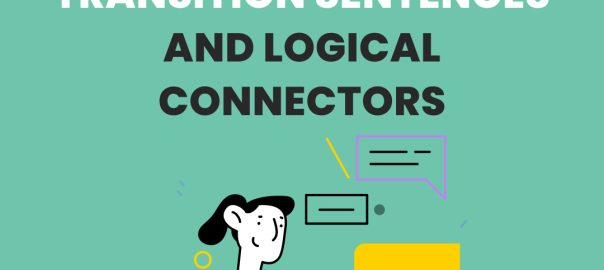
A Guide to Using Transition Sentences and Logical Connectors
Table of Contents:
1.Why are Transition Sentences and Logical Connectors Important?
2.What is a Transition Sentence?
3.Types of Transition Sentences
-Transitioning Between Paragraphs
-Transitioning to a New Section
-Transitions within a Paragraph
4.Using Transition Words and Phrases: Examples and Applications for Smooth Transitions
5.What are the Logical Connectors
6.Logical Connectors Examples

Why are Transition Sentences and Logical Connectors Important?
Professionals and supervisors often recommend that their students use transition sentences to improve their text several times and make it more readable. In addition, students should not only use standard phrases just because of this requirement but also try to come up with their own. Thanks to this, the logical development of ideas will improve, and your paragraphs will relate to each other. While you ponder the idea of not using simple enumerations, we’ll tell you all about how the transition in sentence can change your research paper.
What is a Transition Sentence?
In many ways, even the most straightforward sentence for transition allows you to take your idea from one paragraph to the next grade. You can do the same with theses or arguments, meaning this writing format is highly valued among grading teachers. It’s an opportunity to build your sequences into a logical chain and achieve great results.
The key goal is for your audience and individual readers to follow the narrative without difficulty. A good indicator of the proper use of such sentences is to allow the reader to answer a few questions:
- how several concepts are related, and whether they are related at all;
- how one premise could be the basis for a completely different concept;
- to what extent do two different things depend on each other.
This makes the sentence with transition your primary tool for creating a logical flow of thought. The essay benefits from this because it becomes clear and fluid. It also allows you not to cut off your thoughts halfway through and start the next paragraph of unrelated text. Combine the different points of your essay to show a finished and coherent work to the entire audience.
Extremely often, transition in an essay is used precisely to connect different sentences. In this regard, it’s easy to compare them to common conjunctions, which help to form a firm connection between different objects in an academic paper. One can take as an example an ordinary conversation between two people. One cannot form a coherent speech without gaps without such sentences, so one should not do so in writing either.
There is a crucial rule that talks about commas in different situations. For example, both sentences may be complete so that a semicolon can join them. This will create a strong connection and show the relationship between the objects or phenomena. It is also an excellent opportunity to give some pauses during the reading, which will strengthen the effect of the integrity of your creation.

You can often write a good transition sentence example only if you initially learn the different types of English sentences. This will allow you to handle commas and place them in the right order confidently. Try organizing your work correctly because illiterate speech will eat up your points during your supervisor’s review. The linking sentences should be used in almost every main paragraph at the beginning. This will allow you to move smoothly from idea to idea and gradually immerse your readers in the material.
Authors can use a few advantages to create a logical structure. For example, you can state how one event affected the bottom line. When explaining what is a transition sentence, you can give a relatively simple example, “Alex didn’t do his homework for a month. As a result, he got a low grade.” This simple example shows that because of the explanation about failing homework, the reader immediately has the logic that he got a low grade.
To make it even simpler, you can view your entire academic paper as a large number of different bricks. Each one is a specific sentence that argues a fact, a proof, or some event. However, just putting them next to each other won’t help you build a house because it will be flimsy and fall apart quickly. You need a special mortar to hold the bricks together.
That’s precisely the kind of solution that linking sentences are. You make each piece of text work together with the other, and so you give your academic work strength. The essay becomes several times easier to read and argumentative. It helps to understand your thought and its development, which means the audience will be closer to the author and more readily agree with the arguments. Tell through transitions precisely what readers should do with the information they receive. This helps organize your narrative and make it understandable to a wide range of people.
Types of Transition Sentences
Our examples of transition sentences will often include different types of these constructions because they are used in different places in the text. Some are necessary for use between paragraphs, while others separate entire sections. Proper use will help you summarize your thoughts and reach a more concise statement. It’s a short introduction that reminds readers what they’ve learned before.
With these smooth variations of transitions, you get a much deeper understanding of the topic and don’t miss any critical aspects of the writing. You can also try different ways of conveying information this way and not lose the reader’s interest as you read your work. Use a writing format so your audience perceives each transition to a conclusion without too many problems. You allow the reader to anticipate the following data they will soon receive and use independently.
A few of the most popular ways to use essay transition sentences correctly exist. The most commonly shared options are where such connections will be most appropriate:
- at the beginning of a separate paragraph that will signal further information and summarize the previous words;
- as a link between several pieces of evidence and the final result. Allow your readers to understand the topic better;
- try to use sentences with connectors at the end of each paragraph so that the reader will have already formed an opinion about the topic presented in the next.

This is also an excellent opportunity to create a link between your arguments and summarize them in the conclusion section. When asking how to transition between paragraphs, you must be as careful as possible about all the data presented. You can go overboard with linked sentences, confuse the reader, and give him the wrong signals. Try to use each transition for a conclusion as appropriately as possible, creating a proper and logical flow of thought from one place in the text to another.
Transitioning Between Paragraphs
When asking what is a transition in writing, you need to understand that it is the simplest version of special sentences. There are several key purposes for using it between paragraphs:
- to allow for a logical continuation of the topic;
- allow the reader to anticipate the further development of the topic;
- to improve comprehension and reinforce the information in the previous paragraph.
All these provide an opportunity to help your audience understand your train of thought and correctly recognize the hints to continue. Try to use one or two words that work perfectly. Often these transitions can be located at the end of the first paragraph or in the very introduction of the next. In this case, you connect the two, allowing readers to delve deeper into the topic.
Transitioning to a New Section
In this case, the transition statements will recall key information in the past section and use it correctly in the new one. More often than not, such connections will be necessary for you in highly voluminous works, which can easily confuse the reader. This way, the audience will not get lost in the vastness of the text, will be able to remember the previous information, and understand its value in the new section. It is best to show such text fragments to the supervisor before handing them in because novice students sometimes make a few mistakes in composing such sentences.
Remember, first of all, that the examples of transition should not be too voluminous and extensive. It is best to fit into a minimum number of words, allowing the reader to understand what will be discussed. Be sure to emphasize only the important places the audience needs to read the new section. In this case, your essay will look coherent and read without unnecessary problems.
Transitions within a Paragraph
Students often underestimate the necessity of transition within a paragraph, although it is an essential element of a properly written essay. All thanks to the ability to make the following text more accessible and understandable. You should allow your readers to anticipate your thoughts so that they remain interested and understand the essence of your position. Present the text in the form of a line, and such transitions will be some dashes with a hint so that the listener always knows precisely what he has read before.

Using Transition Words and Phrases: Examples and Applications for Smooth Transitions
It is essential to understand that transition sentences in an essay are your opportunity to improve the readers’ understanding of your scholarly text significantly. Thanks to this, the essay will become much more interesting and logical, and the audience itself will be able to come to the necessary conclusions and reactions with less effort. It is worth using special transitions, which, more often than not, consist of a single sentence or a whole paragraph.
Doing this, you smoothly move your thoughts forward and develop the topic in-depth, discussing all aspects. The best way to improve your writing is to use the last sentence of the first paragraph or the first sentence of the second paragraph. This way, readers will have a certain reading pattern and are guaranteed not to get confused by the information. This is especially true for those students who now have to work with lengthy research papers.
You should also use word connectors for essays to create a clear structure in your work that the teacher and your audience will appreciate. It is worthwhile in this case to try to understand the main advantages of this writing format:
- sentences connector allow you to combine several concepts and lead your thought and argument from one to the next. Such seamless transitions allow you to explore aspects of one thesis and move on to the second. It will also allow you to use transitions from broader to narrower topics and vice versa effectively;
- your research paper will become several times more dynamic and begin to attract the audience with its structure. Transitions between paragraphs move the narrative forward while keeping readers focused. You always win when the audience does not forget about your arguments and the information conveyed earlier.
- the readability of your text will significantly increase. All thanks to a high understanding of your thought progression in readers. Everyone will understand where you began your narrative and where you want to arrive. You will also allow the audience not to forget the aforementioned essential aspects. In bad works, it only works in the closing paragraphs, but in yours, it can simultaneously work in all the paragraphs!
Remember that all connectors sentences allow you to make your work less cliffy and dry. This gives you a wide variety of additional techniques while you are writing and allows you to keep anyone from getting bored. Try to always think about how readers will perceive your work, which means keeping a constant line of communication in mind. Eventually, you’ll get better and better at using such transitions.

What are the Logical Connectors
Most sentence connectors words are necessary to develop your thought and compensate for gaps actively. Readers can follow your narrative and the development of specific ideas in the text without any problems. The logical connectors are words that allow you to combine several sentences, paragraphs, and sections. The easiest way to imagine them by category:
- contrasting. Such sentences are used to create a contrast between several events, evidence, and objects. Thanks to such words, it is possible to compose more complex sentences, to tell about two sides of the coin at once;
- result. The most popular option to express the consequences of actions. Thanks to it, it is possible to explain in simple language how the manifestation of one event led to a certain result in the future or the past. Most often, such connectors are considered informal;
- complement. In this case, connectors will work for the integrity of your story and thus add information to the existing facts. This is the second thought in one sentence, which complements the first. Thanks to this, you can tell that a person likes rice but also likes pasta;
- cause and purpose.It is best to use transition in a sentence to show a logical connection between two events. The occurrence of one situation led to a certain outcome. You explain how because of one person’s actions affect their final goal or another outcome.
There are a large number of other connectors that will also work for results and provide your work with clear meaning. However, you should avoid using academic and informal connectors, which are worse than conventional ones for your audience. Any unnecessary connectives in your sentences will lead to worse readability and thus will make the work more difficult to perceive and give several new challenges to the readers. In what follows, we’ll give you some examples of popular connectors.
All sentence connectors examples are essential for building your scholarly work in a logical plane, where the audience will not need any extra effort to understand what you are talking about. Thanks to this, you can also use such words to combine English sentences. In this way, you better disclose the topic and give more in-depth information about a particular event. Express your thoughts as accurately as possible, thereby not distorting your narrative and claiming maximum marks for such a competent essay.
As you already know, a transition used in a sentence is most often used at the beginning or end of a paragraph, depending on its sequence. That said, there are also both simple and complex connectors. These include:
- simple. And, but, or;
- compound. However, although, except, subsequently, should, therefore.
All of them are also used to convey additional information to readers. This allows you to speak more accurately about a topic and touch on certain aspects of your scholarly work.
Logical Connectors Examples
Here are some clear examples to help you understand connective constructions. This will allow you to build the right sentences in your research papers and give you more points from your supervisor. Remember that properly constructed speech in the essay is a pledge of respect from and to the audience.
| Direction | Connection | Phrase transition |
|---|---|---|
| Time | as, as soon as, since, until, when, whenever | afterward, after all, in the past, lastly, now, before, recently, soon |
| Addendum | the one, who, what, whoever, how many, whatever, why | as a matter of fact, by the way, it is equally important, first of all, also, in addition |
| Reason | because, in order to, since | considering all the circumstances, because of this, for this reason, because |
| Exception | other than | except for, barring, excepting |
| Cause and effect | so it follows, therefore, because | respectively, as a result, therefore, as a consequence, thus |
| Status | if, while, if only, subject to, be | because, it could be |
| Comparison | just like, so | in the same way, again, thus, in a comparison, conventionally speaking |
| Brief conclusion and table of contents | first of all, as has been demonstrated, briefly, in summary, concluding all of the foregoing, summarizing |
Try using essay sentence connectors in your research papers now to get your audience and instructor’s full approval. This is a great chance to add logic to your materials and allow your readers to navigate the text many times better. You’ll learn how to use them much faster than you think!